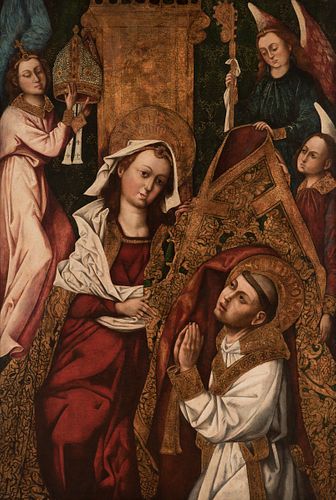Castilian school; first quarter of the sixteenth century. "Virgin imposing the chasuble to San Ildefonso". Oil on panel. Cradled.
Lot 81
About Seller
Setdart Auction House
Carrer Aragó 346
Barcelona
Spain
Setdart Subastas was born in 2004 and is currently the first online art auction in Spain with solidity, prestige and reliability guaranteed by our more than 60,000 users. Setdart has a young, dynamic and enterprising team ready to successfully manage the purchase and sale of art works through custom...Read more
Estimate:
EUR€17,000 - EUR€20,000
$18,279.57 - $21,505.38
Absentee vs Live bid
Two ways to bid:
- Leave a max absentee bid and the platform will bid on your behalf up to your maximum bid during the live auction.
- Bid live during the auction and your bids will be submitted real-time to the auctioneer.
Bid Increments
| Price | Bid Increment |
|---|---|
| EUR€0 | EUR€10 |
| EUR€200 | EUR€25 |
| EUR€500 | EUR€50 |
| EUR€1,000 | EUR€100 |
| EUR€3,000 | EUR€200 |
| EUR€5,000 | EUR€500 |
| EUR€10,000 | EUR€1,000 |
| EUR€20,000 | EUR€2,000 |
| EUR€50,000 | EUR€5,000 |
About Auction
By Setdart Auction House
Oct 20, 2021
Set Reminder
2021-10-20 07:30:00
2021-10-20 07:30:00
America/New_York
Bidsquare
Bidsquare : OLD MASTERS
https://www.bidsquare.com/auctions/setdart-auction-house/old-masters-7700
Setdart Auction House sofia@setdart.com
Setdart Auction House sofia@setdart.com
- Lot Description
Castilian school; first quarter of the sixteenth century. "Virgin imposing the chasuble to San Ildefonso". Oil on panel. Cradled. Brushed board, has restoration. Size: 149 x 101 cm; 169.5 x 121 cm (frame). Devotional scene, in which the author presents the Virgin, accompanied by a saint, kneeling before her, and three angels arranged in the upper part of the composition, carrying the crosier, the chasuble and the mitre. This symbolism indicates that it is the representation of a passage from the life of Saint Ildefonso, specifically the one that refers to the night of December 18, 665. When Saint Ildefonso went to the church to sing hymns in honor of Mary, accompanied by his clerics and some other people. However, when they entered, they found the chapel shining with such a dazzling light that they were afraid. All fled except Ildefonso and his two deacons, who entered and approached the altar. Before them stood the Virgin Mary, seated on the bishop's chair, surrounded by a company of virgins singing heavenly songs. Mary beckoned the saint to approach and, having obeyed, she fixed her eyes upon him and said, "You are my chaplain and faithful notary. Receive this chasuble which my Son sends you from his treasury." Having said this, Our Lady herself invested him, instructing him to wear the chasuble only on feast days designated in her honor. St. Ildefonso of Toledo (Toledo, 607-667), son of Visigoth parents and nephew of St. Eugene III, was archbishop of Toledo between 657 and 667, and is one of the Fathers of the Church. He studied in Seville under the tutelage of St. Isidore, and entered the order of St. Benedict fleeing from his parents, nobles who were opposed to his priestly life. He would later be elected abbot of Agalia, near Toledo, and finally archbishop. St. Ildefonso unified the liturgy in Spain, and wrote numerous works of liturgical and dogmatic character, particularly on the Virgin Mary. Spain is, at the beginning of the 16th century, the European nation best prepared to receive the new humanist concepts of life and art due to its spiritual, political and economic conditions, although from the point of view of the plastic forms, its adaptation of those implanted by Italy was slower due to the need to learn the new techniques and to change the taste of the clientele. Soon the anatomy, the movement of the figures, the compositions with a sense of perspective and balance, the naturalistic play of the folds, the classical attitudes of the figures began to be valued; but the strong Gothic tradition maintains the expressiveness as a vehicle of the deep spiritualist sense. This strong and healthy tradition favors the continuity of religious painting by adding a sense of balance that avoids its predominance over the immaterial content that animates the forms. In the first years of the century, Italian works arrived in our lands and some of our artists went to Italy, where they learned first hand the new norms in the most progressive centers of Italian art, such as Florence or Rome, and even in Naples.
- Shipping Info
-
In-house shipping available. Please inquire at admin@setdart.com.
-
- Buyer's Premium



 EUR
EUR CAD
CAD AUD
AUD GBP
GBP MXN
MXN HKD
HKD CNY
CNY MYR
MYR SEK
SEK SGD
SGD CHF
CHF THB
THB









